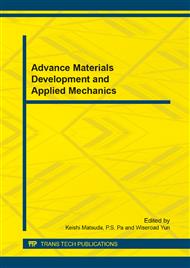p.401
p.407
p.411
p.417
p.421
p.425
p.431
p.435
p.439
Experimental Study of Corrosion Sensors for the Design Technology of Bridge Longevity
Abstract:
Corrosion of steel reinforcement is a major factor in the deterioration of harbor and bridge structure. Steel corrosion in concrete must be checked for investigating the condition of a reinforced concrete structure. The several way how to measuring corrosion condition of reinforced concrete, but the corrosion potential measurement is a very simple, rapid, cost-effective and non-destructive technique to evaluate the severity of corrosion in reinforced concrete structure. However some particular situations may not relate to the reinforcement corrosion probability and a simple comparison of the corrosion potential data with the ASTM Standard on steel reinforcement corrosion probability could prove meaningless because of environment factors as oxygen concentration, chloride content, the concrete resistance. Therefore this paper proposed compact designed corrosion sensors to monitor several corrosion factors, and the electrochemical measurement and evaluation have been carried out to investigate rebar corrosion, and a reasonable prediction of corrosion has been obtained in terms of nondestructive electrochemical point of view.
Info:
Periodical:
Pages:
421-424
Citation:
Online since:
July 2014
Authors:
Keywords:
Price:
Сopyright:
© 2014 Trans Tech Publications Ltd. All Rights Reserved
Share:
Citation:


